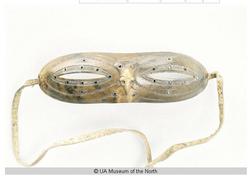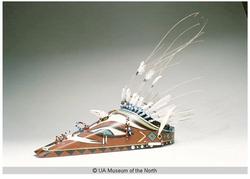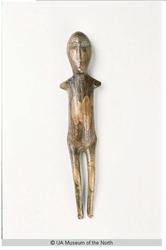 |
| Ivory snow goggles with possible owl detail |
 |
Art is part of the system of survival. It allows cultures to thrive through the expression of individuals, empowers people to construct their identities, and serves as a way of telling. For Alaska Native people, art permits a means of communication that is beyond written language. Our spoken and sung expressions, the images we make visually and materially, and the patterns that we establish and emphasize as we create work as way of communicating across time and with each other.
A work of art becomes a way of speaking with the past and the future as well as in the moment that it is created. One who creates art places a sense of order and expression in time that will be taken in later by another audience. This audience is shaped by experiences and events that have taken place since the object's creation; these experiences let the audience interpret the object in ways that adds meaning and significance to the art itself. John Pingayaq, well-known as "the Beethoven of the tundra," is Cup'ik artist. He is a carver, composer, sculptor, and teacher. He talks about how he had a difficult time when he tried to get at the ideas behind traditional Cu'pik values:
"When my grandfather began telling me stories of our ancestry, it was difficult for me to understand the Cup'ik philosophy embedded in those stories, because it involved a complex way of thinking. This mental block prevented me from understanding our ancestral way of life through my grandfather's eyes. My mental block can be described as not having experienced what my grandfather did, before extensive contact with Western civilization. The 'window to the past' was a complicated intellectual skill I had to develop. To accurately record the stories on paper, I had to visualize them."
He talks about the need to translate ideas into things that he could see in order to understand them fully. This, in and of itself, is art. Such a gift and impulse lies at the root of his creative and artistic skill. As a carver, his role is one of working images from raw material. Although carving is only one of the many art forms that Alaska Native people have refined over the course of thousands of years, it deserves particular attention because of the central place it continues to occupy in contemporary art.
To carve means to control surfaces precisely, whether the surfaces are ivory, bone, antler, horn, stone, petrified tusk, metal or wood. A carver's strokes may be percussive -- with adze, rock, or some other way of hitting material -- or they may be cut, abraded, or polished. In any case, a positive image is left as material is removed or worn away. It is transformed from raw form to rough shape, and then worked into just the right finish. This image may be polished, painted, shaded, tinted, etched or sealed.
Carvings are sculptures, whether in their finished form they end up as useful objects -- combs, strengthening inlays, handles, toys, scrapers, needles, knives, hooks, weights, sled runners, utensils, snow beaters, harpoon tips or counterweights, arrows, knives, models, boxes, containers, paddles, platters, goggles, berry picking winnowers or teeth, or bowls for seal oil -- or as display. Carvings may be metaphors, performance, mediating objects, symbols, signs of ownership, ways of telling history, dolls, maps or miniatures. They may become jewelry: labrets, earrings, bracelets, rings, or beads. They are products of imagination and interpretation. They may be allegorical, abstract or representational and have political functions. They may have no function. They may speak of personal and cultural memory.
 |
| Wood visor with ivory beads, figures, and harpoon head |
 |
Carvings stand out for the way they show transformation: from human to animal, organic to inorganic, conception to physical thing. They permit and embody identity, status, and respect. As part of regalia, carvings may be ceremonial objects. They may be signs of leisure time and plenty. Through the substances they are made of -- from animals, mineral, or vegetable -- they show what items are commodities. Carvings tell what resources are available to artists. They may reflect a shortage or bounty of materials and tools. A collection of carvings may be more striking through repetition of form or expression.
Along with other forms of Alaska Native art, carving is traditionally linked with gender. While women typically did beading, quillwork, basketry, sewing and other textile work, men carved. In the men's houses, older men taught younger men how to carve. My grandfather spoke only in the Inupiaq language. My grandmother showed him how to copy the shapes of the letters that spelled his name out in English: he copied his name, J-O-H-N K-O-K-U-L-U-K, and etched it onto each of his carvings. Like other King Island men who learned how to carve in one of the three men's clubhouses on King Island he was an expert carver, but he was never above sharing his knowledge. Ronald Senungetuk, the Inupiaq master visual artist from Wales, once told me how my grandfather treated him with patience and kindness when he himself was a young man learning how to establish himself as a carver. In a public statement made just before the passage of the Alaska Native Claims Settlement Act, Senungetuk related the role of to the larger Alaska Native rights movement:
"The prospects for cultural revolution or emergence of new culture may come out of the land claim settlement. The ethnic groups need a vehicle with which to relate their position in the world. The possibility of creating a great design center on the North would be a contribution that would reveal monumental heritage that the groups possess. The design product does not have to stop at houses and vehicles that can withstand cold weather. The products could be in music, drama and every aspect of visual arts. The growth does not have to stop in arts alone. The growth depends on the ability of man."
 |
| Okvik-era human figure carved from ivory |
 |
From the carvers of the famous Okvik Figure, which Gail Hollinger describes as "just a small thing, maybe four inches high and broken at that, but it's imbued with mystery and power all the same," to the commercial success of bilikens imagined and made by Inupiaq carver Happy Jack Angokwazhuk, carving does speak to the human ability and our capacity to thrive together.
Happy Jack Angokwazhuk:
http://www.litsite.org/index.cfm?section=Digital%20Archives&page=People%20of%20the%20North&Cat=Native%20Lives%20and%20Traditions&ContentId=2657&viewpost=2
Okvik Figure:
http://www.litsite.org/index.cfm?section=Libraries%20and%20Booksellers&page=Library%20Programs&ContentId=641&viewpost=2
John Pingayaq:
http://www.litsite.org/index.cfm?section=History-and-Culture&page=Cultural-Heritage&viewpost=2&ContentId=846
http://pingayaq.com/
|
 |
|




